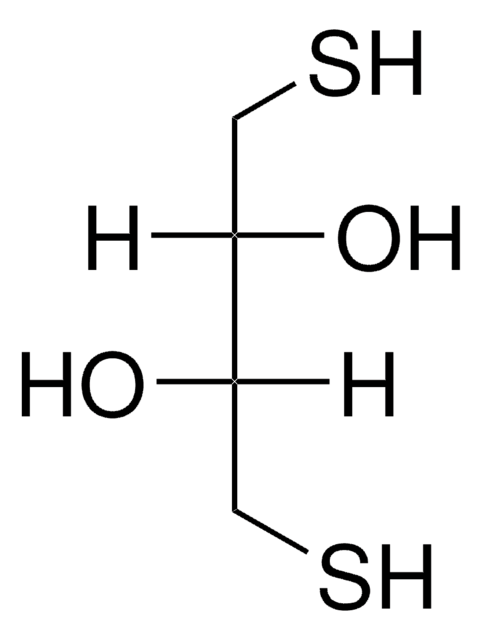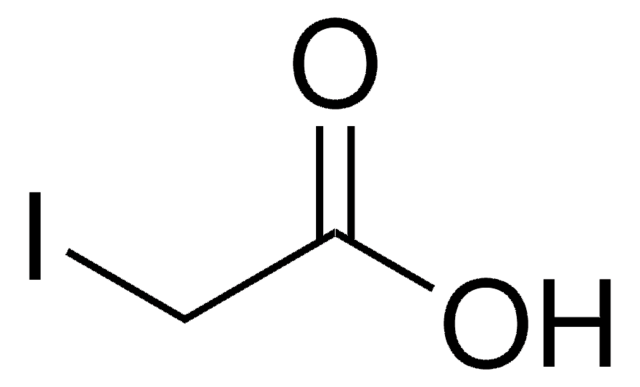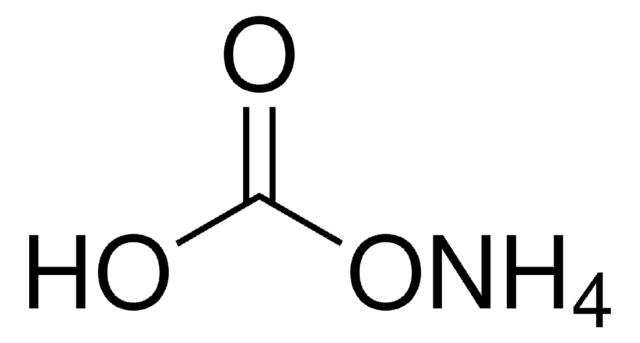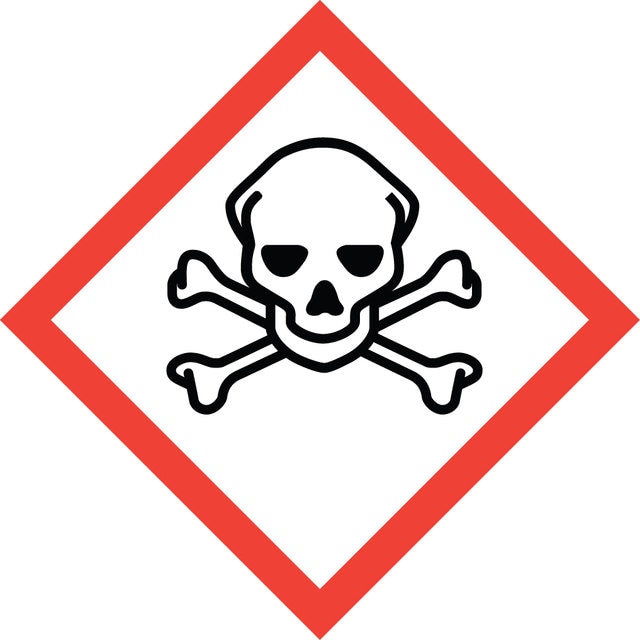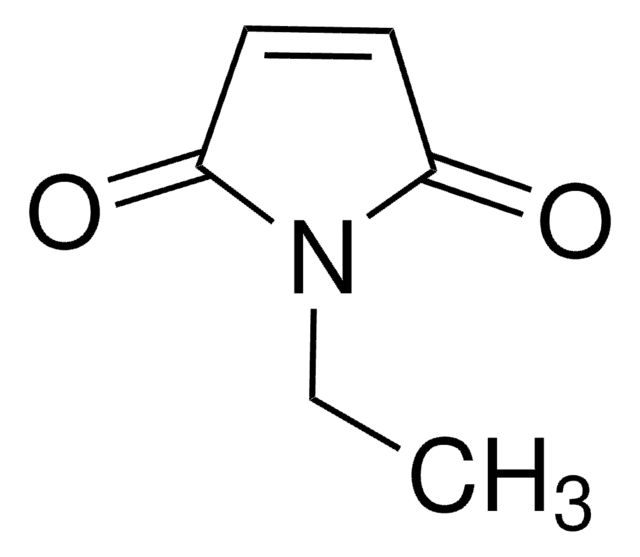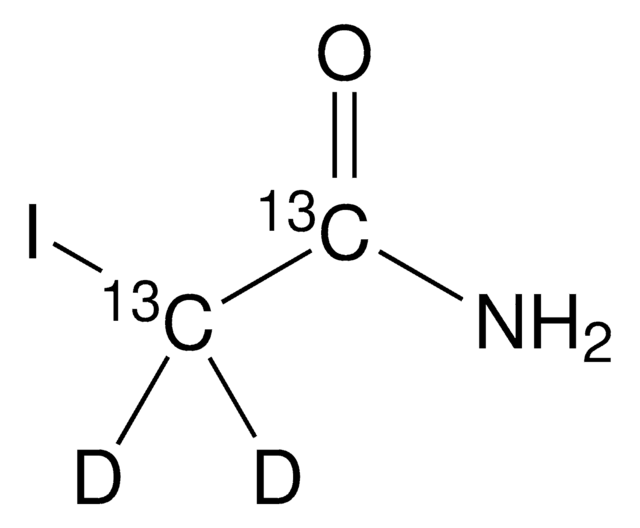추천 제품
생물학적 소스
synthetic (organic)
Quality Level
제품 라인
BioUltra
분석
≥99% (NMR)
양식
powder
불순물
≤0.0005% Phosphorus (P)
≤0.1% Insoluble matter
mp
92-95 °C (lit.)
solubility
H2O: 0.5 M, clear, colorless
음이온 미량물
chloride (Cl-): ≤0.05%
sulfate (SO42-): ≤0.05%
양이온 미량물
Al: ≤0.0005%
Ca: ≤0.0005%
Cu: ≤0.0005%
Fe: ≤0.0005%
K: ≤0.005%
Mg: ≤0.0005%
NH4+: ≤0.05%
Na: ≤0.05%
Pb: ≤0.001%
Zn: ≤0.0005%
저장 온도
2-8°C
SMILES string
NC(=O)CI
InChI
1S/C2H4INO/c3-1-2(4)5/h1H2,(H2,4,5)
InChI key
PGLTVOMIXTUURA-UHFFFAOYSA-N
유사한 제품을 찾으십니까? 방문 제품 비교 안내
애플리케이션
Iodoacetamide has been used:
- in protein digestion for proteomic analysis
- to alkylate protein samples
- in the denaturation of cow′s milk allergens, β-lactoglobulin (BLG) and α-lactalbumin (ALA)
생화학적/생리학적 작용
Iodoacetamide (IAA) is used to inhibit glycolysis due to its ability to irreversibly inhibit the glycolytic enzyme glyceraldehyde-3-phosphate dehydrogenase (GAPDH). IAA is used to investigate the role of cysteine residues in enzyme catalysis and the brain cell transport process. It can react with low molecular weight thiol compounds like mercaptoethanol and glutathione. IAN may also block enzymes like bromelain, cathepsin C, clostripain, and carboxypeptidase P.
Iodoacetamide acts as an alkylating reagent for cysteine residues in peptide sequencing. It is an irreversible inhibitor of enzymes with cysteine at the active site. It reacts much more slowly with histidine residues, but that activity is responsible for inhibiting ribonuclease.
신호어
Danger
유해 및 위험 성명서
Hazard Classifications
Acute Tox. 3 Oral - Aquatic Chronic 4 - Resp. Sens. 1 - Skin Sens. 1
Storage Class Code
6.1C - Combustible acute toxic Cat.3 / toxic compounds or compounds which causing chronic effects
WGK
WGK 3
Flash Point (°F)
Not applicable
Flash Point (°C)
Not applicable
개인 보호 장비
Eyeshields, Faceshields, Gloves, type P2 (EN 143) respirator cartridges
이미 열람한 고객
Tommy Weiss-Sadan et al.
Theranostics, 9(20), 5731-5738 (2019-09-20)
Despite the common use of lipid-lowering medications, cardiovascular diseases continue to be a significant health concern. Atherosclerosis, one of the most frequent causes of cardiovascular morbidity, involves extensive inflammatory activity and remodeling of the vascular endothelium. This relentless inflammatory condition
Konstantinos Boulias et al.
Molecular cell, 75(3), 631-643 (2019-07-08)
mRNAs are regulated by nucleotide modifications that influence their cellular fate. Two of the most abundant modified nucleotides are N6-methyladenosine (m6A), found within mRNAs, and N6,2'-O-dimethyladenosine (m6Am), which is found at the first transcribed nucleotide. Distinguishing these modifications in mapping
Mirko Zaffagnini et al.
Antioxidants & redox signaling, 16(1), 17-32 (2011-06-29)
Cysteines (Cys) made acidic by the protein environment are generally sensitive to pro-oxidant molecules. Glutathionylation is a post-translational modification that can occur by spontaneous reaction of reduced glutathione (GSH) with oxidized Cys as sulfenic acids (-SOH). The reverse reaction (deglutathionylation)
Helen R Stagg et al.
The Journal of cell biology, 186(5), 685-692 (2009-09-02)
The US2 and US11 gene products of human cytomegalovirus promote viral evasion by hijacking the endoplasmic reticulum (ER)-associated degradation (ERAD) pathway. US2 and US11 initiate dislocation of newly translocated major histocompatibility complex class I (MHC I) from the ER to
Valentina R Minciacchi et al.
Oncotarget, 6(13), 11327-11341 (2015-04-11)
Large oncosomes (LO) are atypically large (1-10 µm diameter) cancer-derived extracellular vesicles (EVs), originating from the shedding of membrane blebs and associated with advanced disease. We report that 25% of the proteins, identified by a quantitative proteomics analysis, are differentially
자사의 과학자팀은 생명 과학, 재료 과학, 화학 합성, 크로마토그래피, 분석 및 기타 많은 영역을 포함한 모든 과학 분야에 경험이 있습니다..
고객지원팀으로 연락바랍니다.
